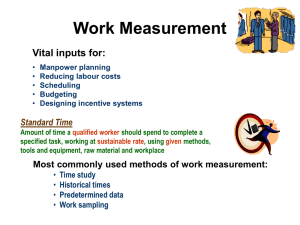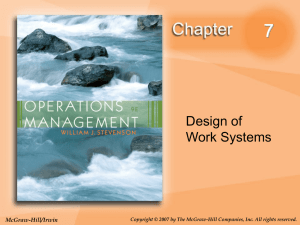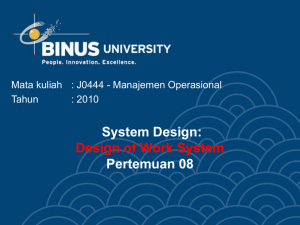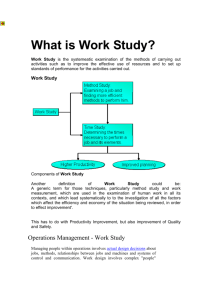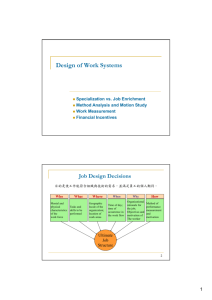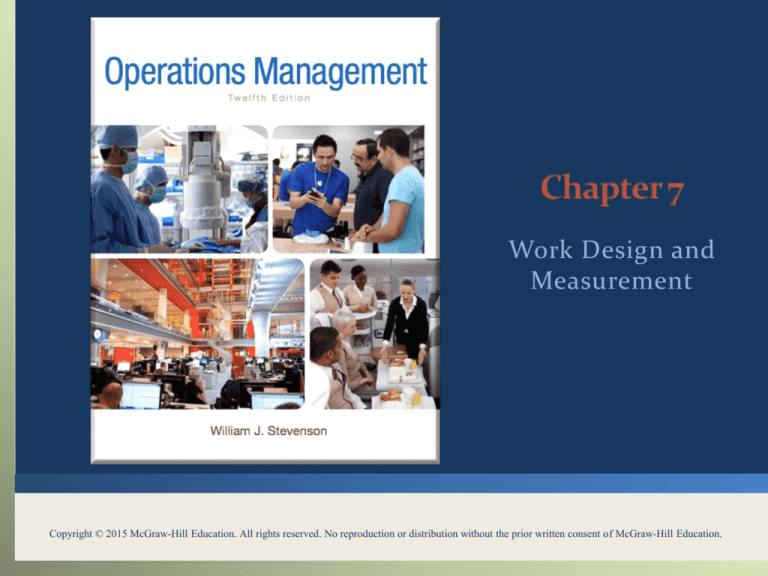
Work Design and
Measurement
Copyright © 2015 McGraw-Hill Education. All rights reserved. No reproduction or distribution without the prior written consent of McGraw-Hill Education.
You should be able to:
LO 7.1
LO 7.2
LO 7.3
LO 7.4
LO 7.5
LO 7.6
Explain the importance of work design
Compare and contrast the two basic approaches to job design
Discuss the advantages and disadvantages of standardization
Describe behavioral approaches to job design
Discuss the impact of working conditions on job design
Compare the advantages and disadvantages of time-based and outputbased pay systems
LO 7.7 Explain the purpose of methods analysis and describe how methods
studies are performed
LO 7.8 Describe four commonly used techniques for motion study
LO 7.9 Define a standard time
LO 7.10 Describe and compare time study methods and perform calculations
LO 7.11 Describe work sampling and perform calculations
LO 7.12 Compare stopwatch time study and work sampling
7-2
Job design
The act of specifying the contents and methods of jobs
What will be done in a job
Who will do the job
How the job will be done
Where the job will be done
Importance
Organization’s are dependent on human efforts to accomplish their
goals
Many job design topics are relevant to continuous and productivity
improvement
Objectives
Productivity
Safety
Quality of work life
LO 7.1
7-3
Efficiency School
Emphasizes a systematic, logical approach to job design
A refinement of Frederick Winslow Taylor’s scientific
management concepts
Behavioral School
Emphasizes satisfaction of needs and wants of
employees
LO 7.2
7-4
Specialization
Work that concentrates on some aspect of a product or
service
Advantages
For management:
1. Simplifies training
2. High productivity
3. Low wage costs
For employees:
1. Low education and skill requirements
2. Minimum responsibility
3. Little mental effort needed
Disadvantages
For management:
1. Difficult to motivate quality
2. Worker dissatisfaction, possibly
resulting in absenteeism, high
turnover, disruptive tactics, poor
attention to quality
LO 7.3
For employees:
1. Monotonous work
2. Limited opportunities for
advancement
3. Little control over work
4. Little opportunity for self-fulfillment
7-5
Job Enlargement
Giving a worker a larger portion of the total task by
horizontal loading
Job Rotation
Workers periodically exchange jobs
Job Enrichment
LO 7.4
Increasing responsibility for planning and coordination
tasks, by vertical loading
7-6
Motivation is a key factor in many aspects of work life
Influences quality and productivity
Contributes to the work environment
Trust is an important factor that affects motivation
7-7
Teams take a variety of forms:
Short-term team
Formed to collaborate on a topic or solve a problem
Long-term teams
Self-directed teams
Groups empowered to make certain changes in their work
processes
7-8
Benefits of teams
Higher quality
Higher productivity
Greater worker satisfaction
Team problems
Some managers feel threatened
Conflicts between team members
7-9
Quality of work life affects not only workers’ overall
sense of well-being and contentment, but also their
productivity
Important aspects of quality of work life:
How a worker gets along with co-workers
Quality of management
Working conditions
Compensation
LO 7.5
7-10
It is important for organizations to develop suitable
compensation plans for their employees
Compensation approaches
Time-based systems
Output-based systems
Incentive systems
Knowledge-based systems
7-11
Time-based system
Compensation based on time an employee has worked
during the pay period
Output-based (incentive) system
Compensation based on amount of output an employee
produced during the pay period
7-12
TIME-BASED
Advantages
Disadvantages
OUTPUT-BASED
Advantages
Disadvantages
Management
Worker
1.
2.
3.
4.
Stable labor costs
Easy to administer
Simple to compute pay
Stable Output
1.
2.
Stable pay
Less pressure to produce
than under output system
1.
No incentive for workers to
increase output
1.
Extra efforts not rewarded
1.
2.
Lower cost per unit
Greater output
1.
2.
Pay related to efforts
Opportunity to earn more
1.
Wage computation more
difficult
Need to measure output
Quality may suffer
Difficult to incorporate wage
increases
Increased problems with
scheduling
1.
2.
Pay fluctuates
Workers may be penalized
because of factors beyond
their control (e.g., machine
breakdown)
2.
3.
4.
5.
LO 7.6
7-13
Individual incentive plans
Straight piecework
Worker’s pay is a direct linear function of his or her output
Minimum wage legislation has reduced their popularity
Base rate + bonus
Worker is guaranteed a base rate, tied to an output standard,
that serves as a minimum
A bonus is paid for output above the standard
Group incentive plans
Tend to stress sharing of productivity gains with employees
7-14
Knowledge-based pay
A pay system used by organizations to reward workers who undergo
training that increases their skills
Three dimensions:
Horizontal skills
Reflect the variety of tasks the worker is capable of performing
Vertical skills
Reflect the managerial skills the worker is capable of
Depth skills
Reflect quality and productivity results
7-15
Many organizations used to reward managers based on
output
New emphasis is being placed on other factors of
performance
Customer service
Quality
Executive pay is increasingly being tied to the success of
the company or division for which the executive is
responsible
7-16
Methods Analysis
Analyzing how a job gets done
It begins with an analysis of the overall operation
It then moves from general to specific details of the job
concentrating on
Workplace arrangement
Movement of workers and/or materials
LO 7.7
7-17
The need for methods analysis can arise from a variety
of sources
1.
2.
3.
4.
5.
LO 7.7
Changes in tools and equipment
Changes in product design or introduction of new
products
Changes in materials and procedures
Government regulations or contractual agreements
Accidents or quality problems
7-18
Identify the operation to be studied, and gather relevant data
2. Discuss the job with the operator and supervisor to get their
input
3. Study and document the present methods
4. Analyze the job
5. Propose new methods
6. Install the new methods
7. Follow up implementation to assure improvements have been
achieved
1.
LO 7.7
7-19
Consider jobs that:
Have a high labor content
2. Are done frequently
3. Are unsafe, tiring, unpleasant, and/or noisy
4. Are designated as problems
1.
Quality problems
Processing bottlenecks
etc.
LO 7.7
7-20
Flow process chart
Chart used to examine the overall sequence of an operation by
focusing on movements of the operator or flow of materials
LO 7.7
7-21
Worker machine chart
Chart used to determine portions of a work cycle during which an
operator and equipment are busy or idle
LO 7.7
7-22
Motion study
Systematic study of the human motions used to perform an
operation
Motion Study Techniques
Motion study principles– guidelines for designing motion-
efficient work procedures
Analysis of therbligs– basic elemental motions into which a job
can be broken down
Micromotion study– use of motion pictures and slow motion to
study motions that otherwise would be too rapid to analyze
Charts– activity or process charts, simo charts (simultaneous
motions)
LO 7.8
7-23
In developing work methods that are motion efficient,
the analyst attempts to
Eliminate unnecessary motions
Combine activities
Reduce fatigue
Improve the arrangement of the workplace
Improve the design of tools and equipment
LO 7.8
7-24
Work measurement is concerned with how long it
should take to complete a job.
It is not concerned with either job content or how the
job is to be completed since these are considered a
given when considering work measurement.
LO 7.9
7-25
Standard time
The amount of time it should take a qualified worker to complete a
specified task, working at a sustainable rate, using given methods,
tools and equipment, raw material inputs, and workplace
arrangement.
Commonly used work measurement techniques
Stopwatch time study
Historical times
Predetermined data
Work sampling
LO 7.9
7-26
Stopwatch Time Study
Used to develop a time standard based on observations of one
worker taken over a number of cycles.
Standard Elemental Times
are derived from a firm’s own historical time study data.
Predetermined time standards
involve the use of published data on standard elemental times.
Work sampling
a technique for estimating the proportion of time that a worker or
machine spends on various activities and idle time.
LO 7.10
7-27
Used to develop a time standard based on observations of
one worker taken over a number of cycles.
Basic steps in a time study:
1.
2.
3.
4.
LO 7.10
Define the task to be studied and inform the worker who will be
studied
Determine the number of cycles to observe
Time the job, and rate the worker’s performance
Compute the standard time
7-28
The number of observations to collect is a function of
Variability of the observed times
The desired level of accuracy
Desired level of confidence for the estimated job time
zs
n
ax
where
2
or
zs
n
e
2
z # of normal stddev. needed for desired confidence
s Sample standard deviation
a Desired accuracy percentage
e Maximum acceptable error
x Sample mean
LO 7.10
7-29
x
OT
i
n
where
OT Observed time
x
i
Sum of recorded times
n Number of observatio ns
LO 7.10
7-30
NT OT PR
where
NT Normal time
PR Performanc e rating
Assumes that a single performance rating has been made
for the entire job
LO 7.10
7-31
NT x j PR j
where
NT Normal time
x j Average time for element j
PR j Performanc e rating for element j
Assumes that performance ratings are made on an elementby-element basis
LO 7.10
7-32
ST NT AF
where
ST Standard time
AF Allowance factor
and
AFjob 1 A
AFday
LO 7.10
1
1 A
A Allowance percentage based on job time
A Allowance percentage based on workday
7-33
Standard Elemental Times are derived from a
firm’s own historical time study data.
Over time, a file of accumulated elemental times that
are common to many jobs will be collected.
In time, these standard elemental times can be retrieved
from the file, eliminating the need to go through a new
time study to acquire them.
LO 7.10
7-34
Predetermined time standards involve the use of
published data on standard elemental times.
Developed in the 1940s by the Methods Engineering Council.
The MTM (methods-time-measurement) tables are based on
extensive research of basic elemental motions and times.
To use this approach, the analyst must divide the job into its basic
elements (reach, move, turn, etc.) measure the distances involved,
and rate the difficulty of the element, and then refer to the
appropriate table of data to obtain the time for that element
LO 7.10
7-35
Work sampling is a technique for estimating the
proportion of time that a worker or machine spends
on various activities and the idle time.
Work sampling does not require timing an activity or involve
continuous observation of the activity
Uses:
1. ratio-delay studies which concern the percentage of a worker’s
time that involves unavoidable delays or the proportion of time
a machine is idle.
2. analysis of non-repetitive jobs.
LO 7.11
7-36
pˆ (1 pˆ )
n
z Number of standard deviations needed to achieve desired confidence
pˆ Sample proportion (the number of occurrence s divided by the sample size
ez
n Sample size
2
z
n pˆ (1 pˆ )
e
e maximum error percent
LO 7.11
7-37
Advantages
1.
2.
3.
4.
5.
6.
7.
Observations are spread out over a period of time, making results less susceptible to short-term
fluctuations
There is little or no disruption of work
Workers are less resentful
Studies are less costly and less time-consuming, and the skill requirements of the analyst are
much less
Studies can be interrupted without affecting the results
No timing device is required
It is well suited for nonrepetitive tasks
Disadvantages
1.
2.
3.
4.
5.
6.
There is much less detail on the elements of a job
Workers may alter their work patterns when they spot the observer, thereby invalidating the
results
In many cases, there is no record of the method used by the worker
Observers may fail to adhere to a random schedule of observations
It is not well suited for short, repetitive tasks
Much time may be required to move from one workplace to another and back to satisfy the
randomness requirement
LO 7.12
7-38
Success factors:
Carried out by personnel with appropriate training and
background
Consistent with the goals of the organization
In written form
Understood and agreed to by both management and
employees
7-39
It is important to make design of work systems a key
element of strategy:
People are still at the heart of the business
Workers can be valuable sources of insight and creativity
It can be beneficial to focus on quality of work life and
instilling pride and respect among workers
Companies are reaping gains through worker
empowerment
7-40


